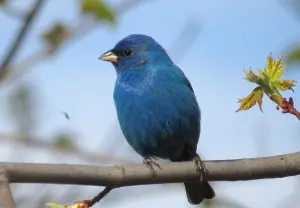Illinois residents, gather here If you love watching birds or love birds visit your backyard. With over 400 bird species recorded in the state, Illinois is a haven for backyard birders. From the iconic Northern Cardinal to the elusive Indigo Bunting, there’s always something new and exciting to spot.
In this post, we’ll introduce you to 30 of the most common and beloved backyard birds found in Illinois. For each species, we’ll provide key identification tips, interesting facts, and ideas for attracting them to your yard. If you are ready, then we are; let’s go!
Also read: How to Keep Birds off Patio Furniture
Take our short quiz
1. Northern Cardinal
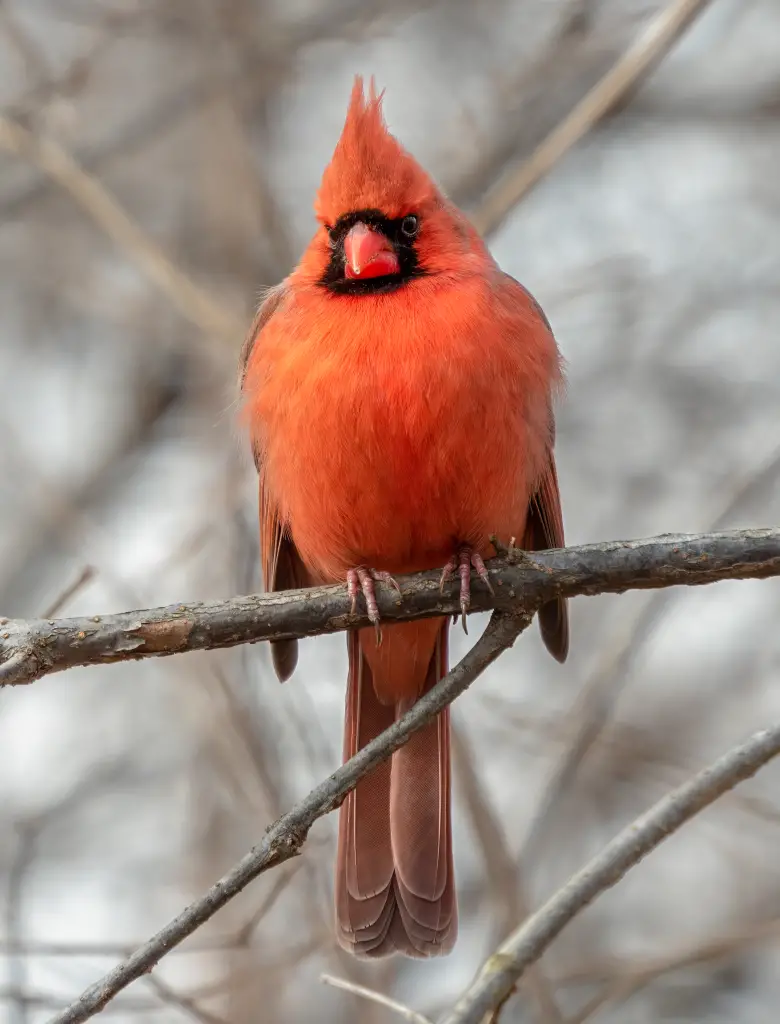
The Northern Cardinal is the official state bird of Illinois and a favorite among backyard birders. Males are unmistakable with their brilliant red plumage, black face mask, and prominent crest. Females are more subdued but still lovely, with warm brown feathers accented by red tinges on the wings, tail, and crest.
Cardinals don’t migrate, so you can enjoy their company year-round in Illinois. They readily visit feeders and are especially fond of sunflower seeds. Planting dense shrubs like holly or dogwood will give cardinals a place to build their nests and take cover.
2. Black-capped Chickadee
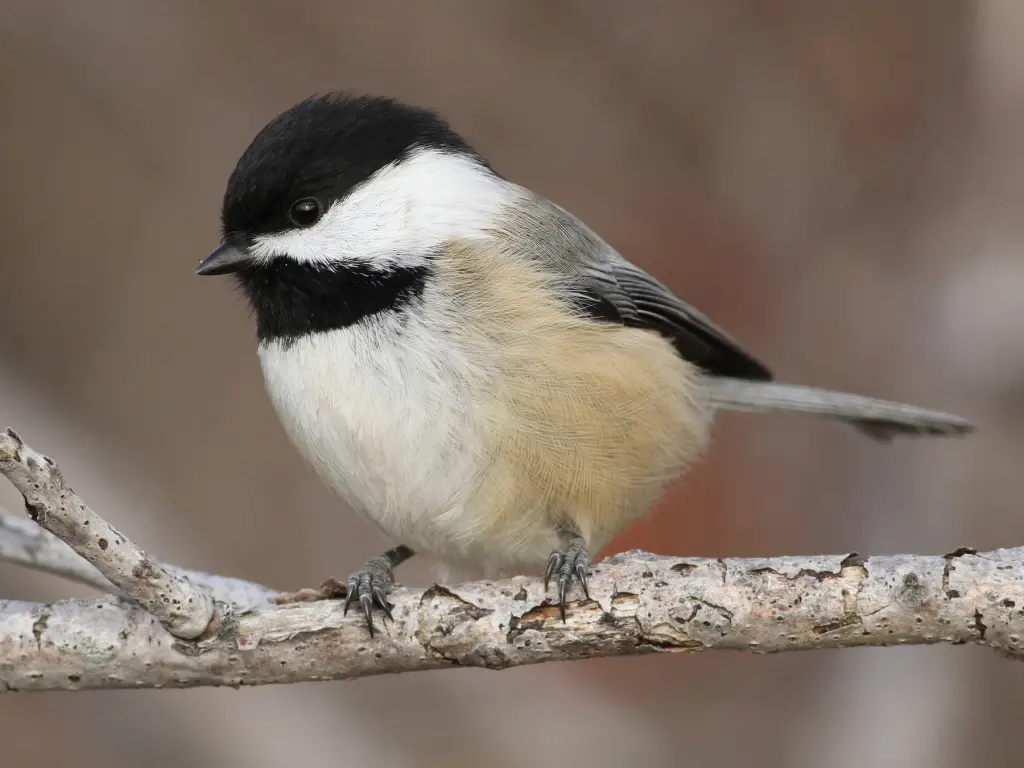
The Black-capped Chickadee is a tiny but spunky bird that’s a common sight at Illinois feeders. With its black cap and bib, white cheeks, and soft gray back, this little bird resembles a miniature tuxedo. Its call is a distinctive “chick-a-dee-dee-dee” that’s easy to recognize.
Chickadees are acrobatic foragers, often hanging upside down to pluck insects and seeds from branches. They love suet and will also readily eat peanuts, sunflower seeds, and safflower seeds from feeders. Planting native trees and leaving dead wood for cavity nests will encourage chickadees to make a home in your yard.
3. American Goldfinch
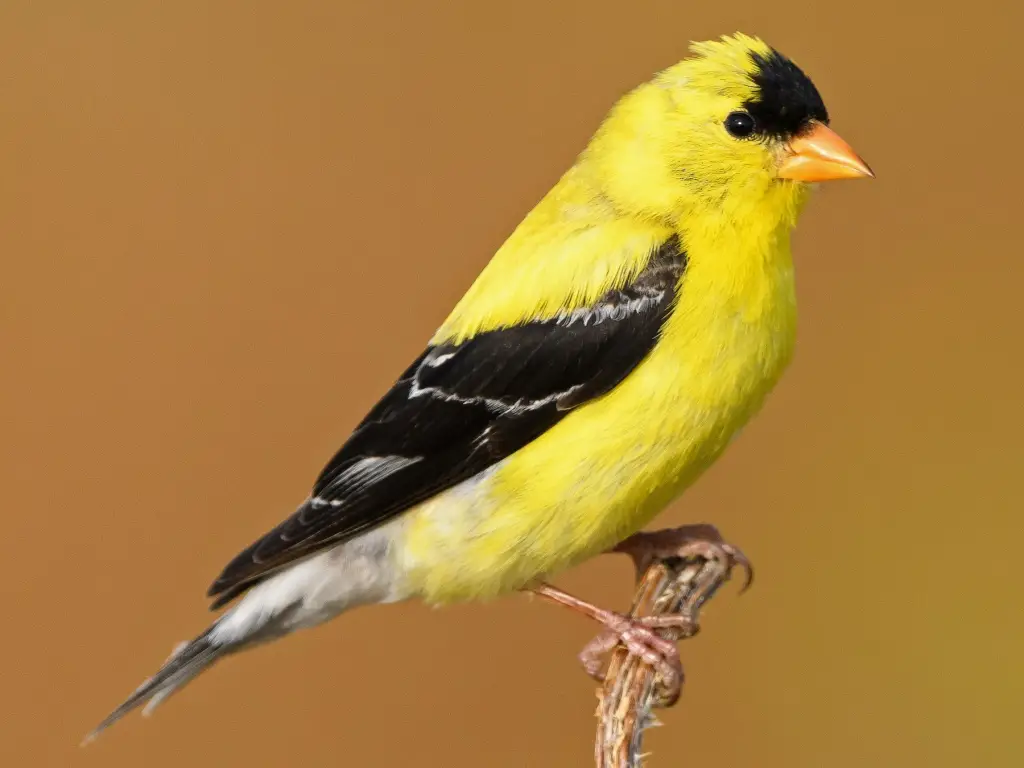
The American Goldfinch is a small, acrobatic finch with a short, conical bill and slightly notched tail. Males in breeding plumage are bright yellow with a black cap and wings. Females and non-breeding males are more olive-brown above and dull yellow below. Goldfinches have a bouncy, undulating flight pattern.
Goldfinches love Nyjer and sunflower seeds. They’re often seen perching on tall, seedy flowers like thistles and coneflowers. To attract goldfinches, plant native seed-bearing flowers and offer nyjer or sunflower seeds in specialized finch feeders.
4. House Finch

The House Finch is a small, chunky finch with a large head and short, conical bill. Males are rosy red around the face and upper breast, with streaky brown back and wings. Females are plain grayish-brown with thick, blurry streaks and no red. House Finches have a fast, warbling song that’s often described as “cheerful.”
House Finches are common feeder birds and love black oil sunflower seeds. They’ll also eat safflower, millet, and nyjer. If you have fruit trees or berry bushes in your yard, you may see House Finches feeding on the fruit or blossoms.
5. Blue Jay

The Blue Jay is a large, boldly marked songbird that’s a common sight in Illinois backyards. It has a blue back, wings, and tail, with a grayish-white belly and a black necklace. Its head is crowned with a striking blue crest. Blue Jays have a variety of loud, raucous calls, including a harsh “jay-jay” and a piercing scream.
Jays are intelligent, curious birds that are sometimes considered bullies at feeders. They love peanuts, sunflower seeds, and corn. Planting oak trees will provide jays with their favorite natural food – acorns. Blue Jays help spread oak forests by caching acorns in the ground, some of which sprout into new trees.
6. Downy Woodpecker

The Downy Woodpecker is a small, black-and-white woodpecker with a short bill and white back. Males have a small red patch on the back of the head, while females lack the red. Downies are often seen hitching along tree trunks and branches, probing for insects with their bills.
Downy Woodpeckers love suet and will also visit feeders for sunflower seeds, peanuts, and millet. They nest in dead trees or branches, excavating a new cavity each year. Leaving dead wood in your yard will provide these little woodpeckers with both food and housing.
7. White-breasted Nuthatch
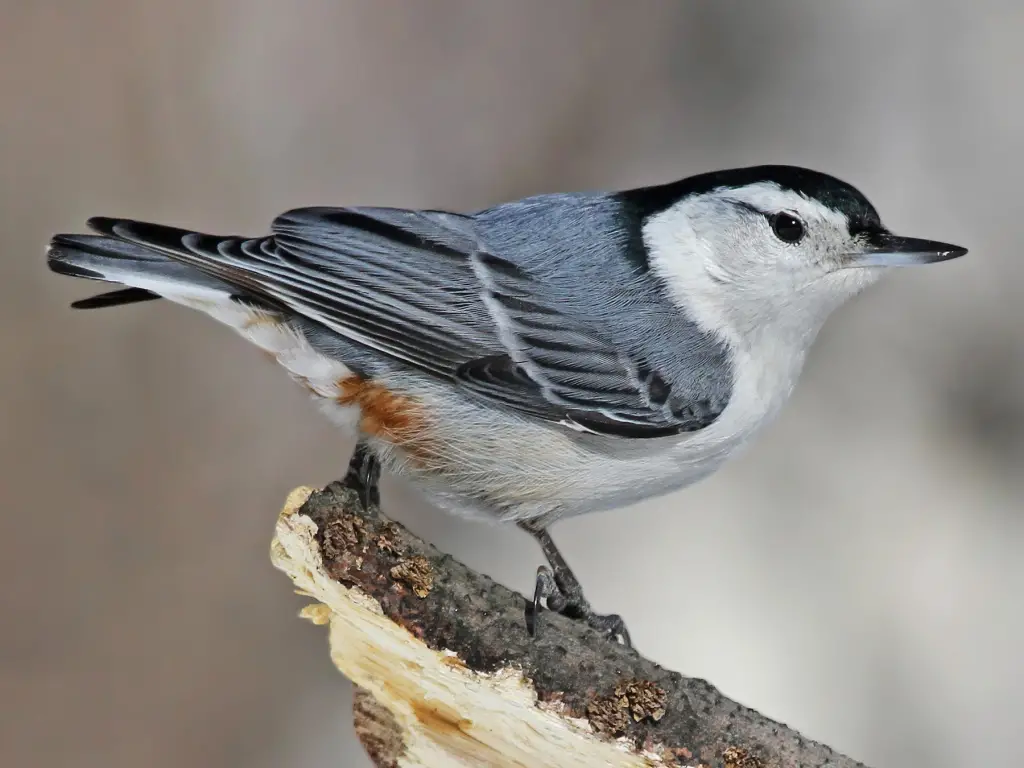
The White-breasted Nuthatch is a small, compact bird with a large head, short tail, and powerful bill. It has a blue-gray back, stark white face and underparts, and a black cap. Nuthatches are often seen creeping headfirst down tree trunks, probing for insects in the bark.
Nuthatches love suet, peanuts, and sunflower seeds. They’ll often grab a seed from a feeder and fly off to wedge it in a crevice and hammer it open. Nuthatches nest in tree cavities, so consider putting up a nest box to attract a breeding pair.
8. Tufted Titmouse
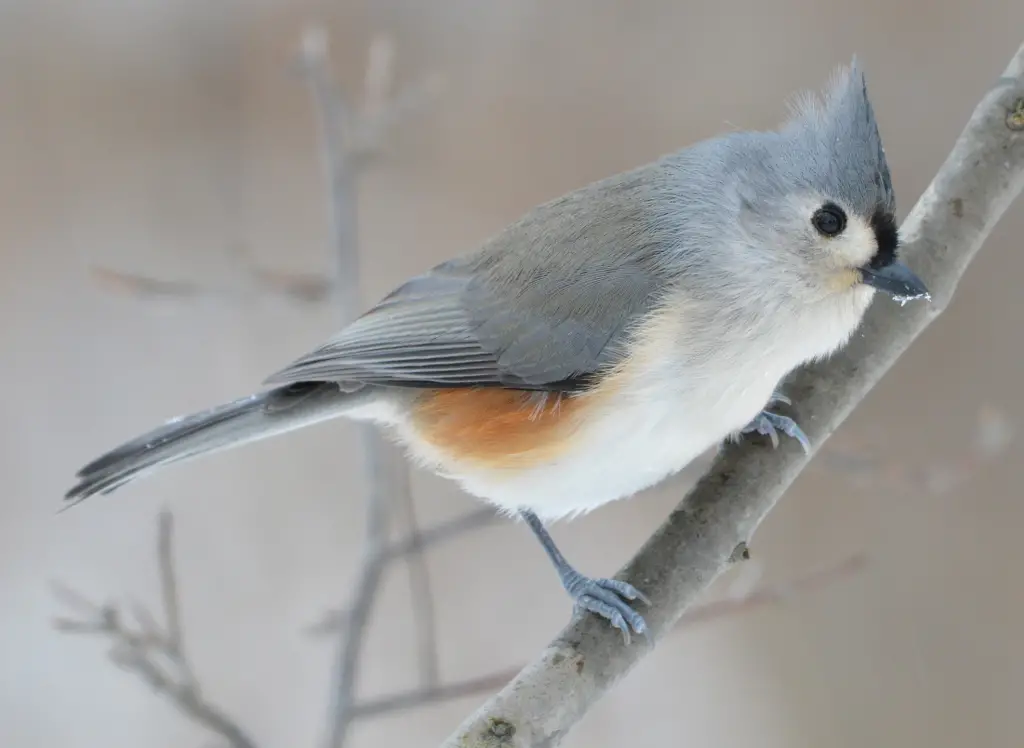
The Tufted Titmouse is another small, active bird that frequents Illinois’ backyard feeders. It has a gray back, white belly, and rusty flanks, with a jaunty crest that gives it a perky appearance. Its call is a loud, ringing “peter-peter-peter” that can be heard from a distance.
Titmice are often seen flitting back and forth from feeders, carrying away a seed to eat elsewhere. They love sunflower seeds, peanuts, and suet. Titmice will also use nest boxes, so consider putting one up to invite these charming birds to raise a family in your yard.
9. Red-bellied Woodpecker
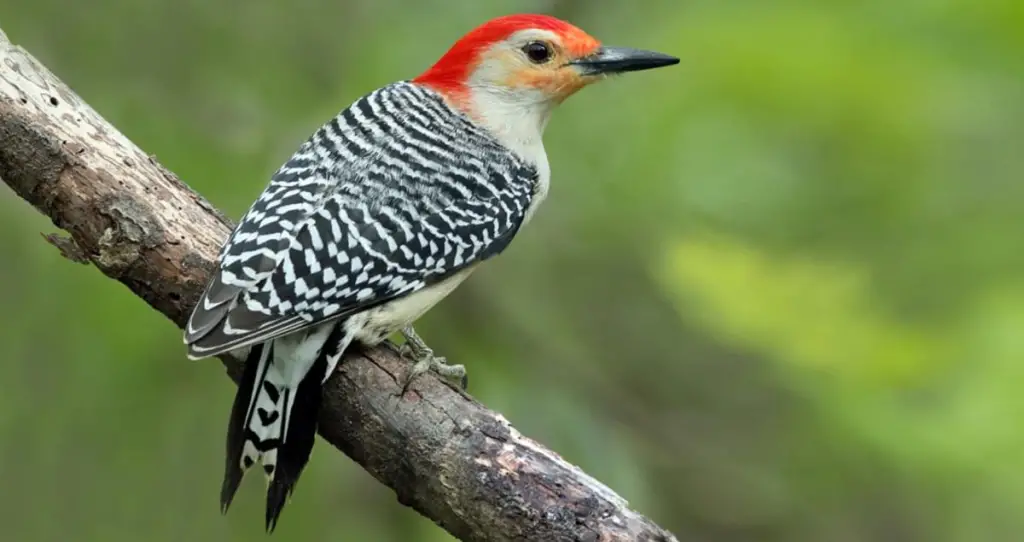
The Red-bellied Woodpecker is a medium-sized woodpecker with striking black-and-white barred upperparts and a pale belly. Contrary to its name, the red on this bird is actually on its head and nape, not its belly. Males have a red crown and nape, while females have a red nape and grayish crown.
Red-bellied Woodpeckers are frequent visitors to suet feeders and will also eat peanuts, fruit, and insects. They excavate nest holes in dead trees or large branches, so consider leaving dead wood in your yard to attract these handsome birds.
10. Mourning Dove
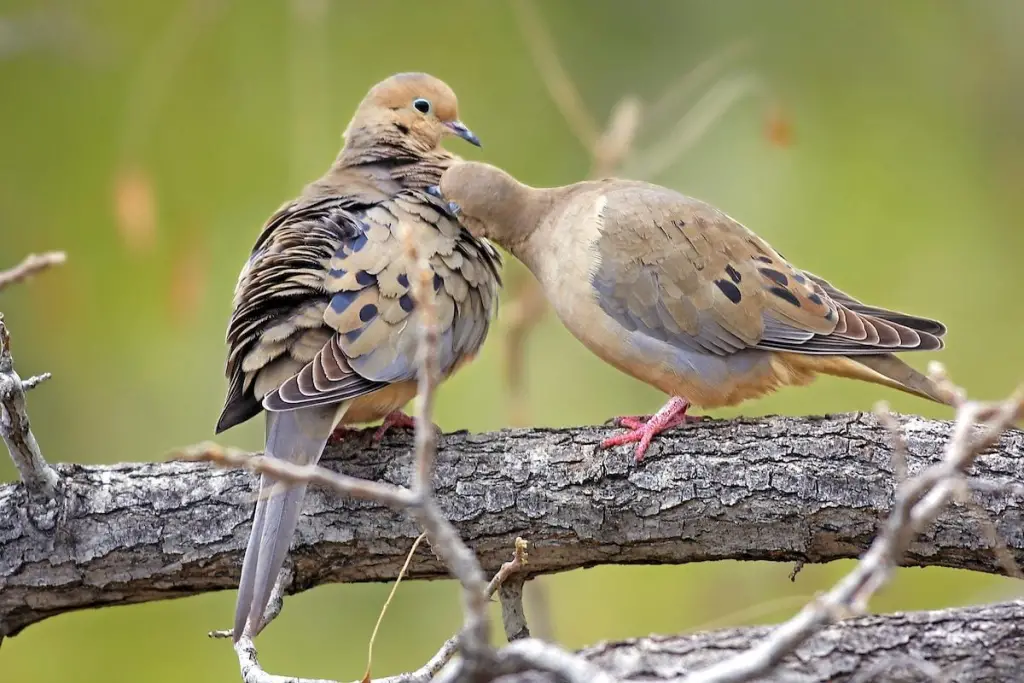
The Mourning Dove is a plump, medium-sized bird with a small head and long, pointed tail. It has grayish-brown upperparts, pale pinkish underparts, and black spots on the wings. Its mournful cooing call is a familiar sound in Illinois backyards.
Doves primarily eat seeds and will readily visit ground feeders or platform feeders. They prefer millet, cracked corn, and sunflower seeds. Doves often nest in the crotches of trees or on horizontal branches, so consider providing nesting platforms to encourage them to raise young in your yard.
11. American Robin
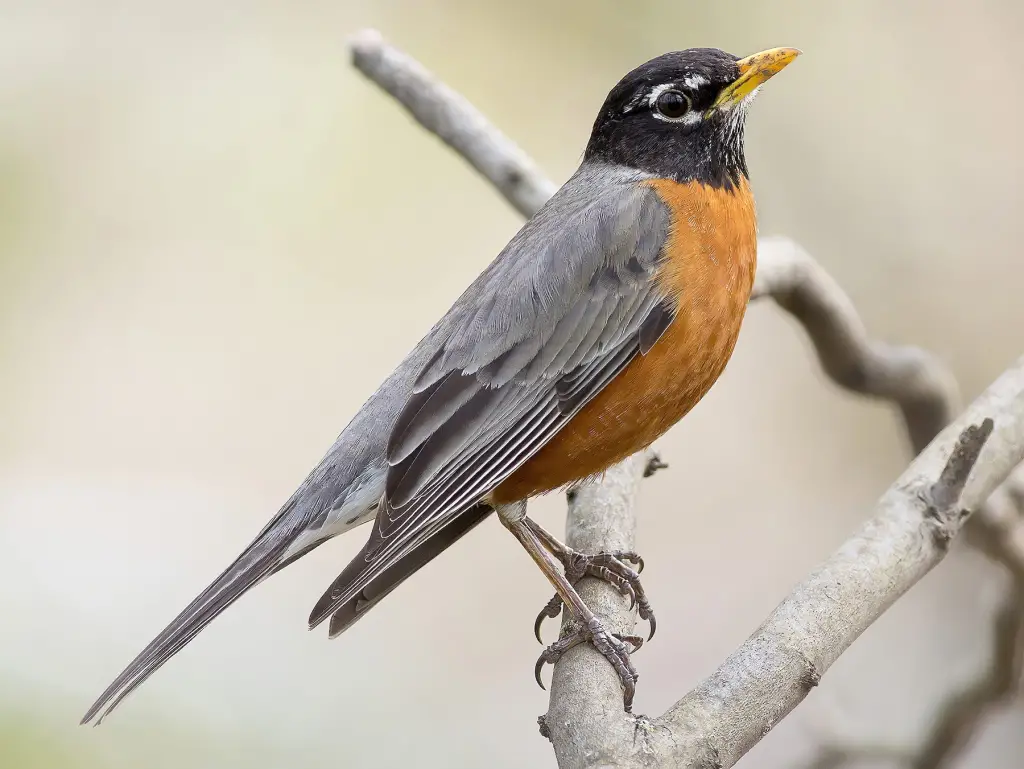
The American Robin is a large, common thrush with gray-brown upperparts, warm orange underparts, and a bold white throat. It has a yellow bill and broken white eye rings. Males and females look similar, but females are paler overall. Robins are often seen hopping on lawns, cocking their heads to listen for worms.
Robins don’t eat seeds, so they rarely visit feeders. Instead, you can attract them by offering chopped fruit, berries, or mealworms on a platform feeder or on the ground. Robins also love to bathe, so consider adding a birdbath to your yard.
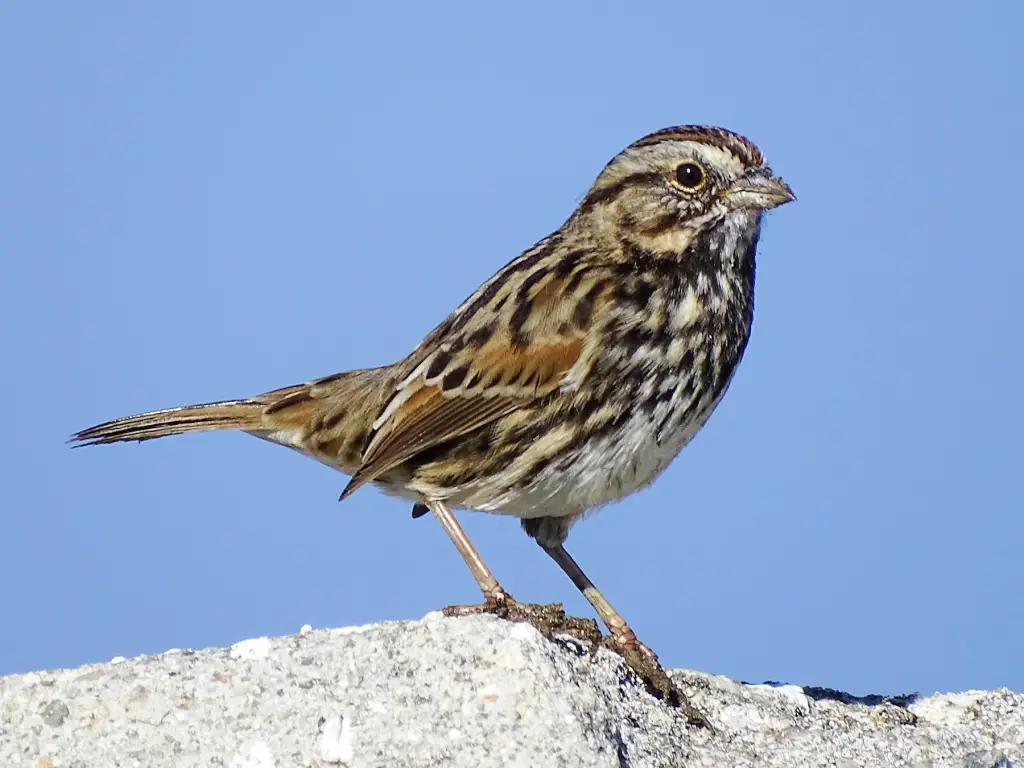
The Song Sparrow is a medium-sized sparrow with a long, rounded tail and thick, seed-cracking bill. It has a brown back with dark streaks, white underparts with heavy brown streaks, and a dark spot in the center of the breast. Song Sparrows are known for their rich, varied songs that often start with three clear notes.
Song Sparrows primarily eat seeds and insects. They may visit ground feeders or low-platform feeders for millet, cracked corn, and sunflower seeds. To attract them, plant native seed-bearing grasses and flowers, or create a brush pile for cover and foraging.
13. Dark-eyed Junco
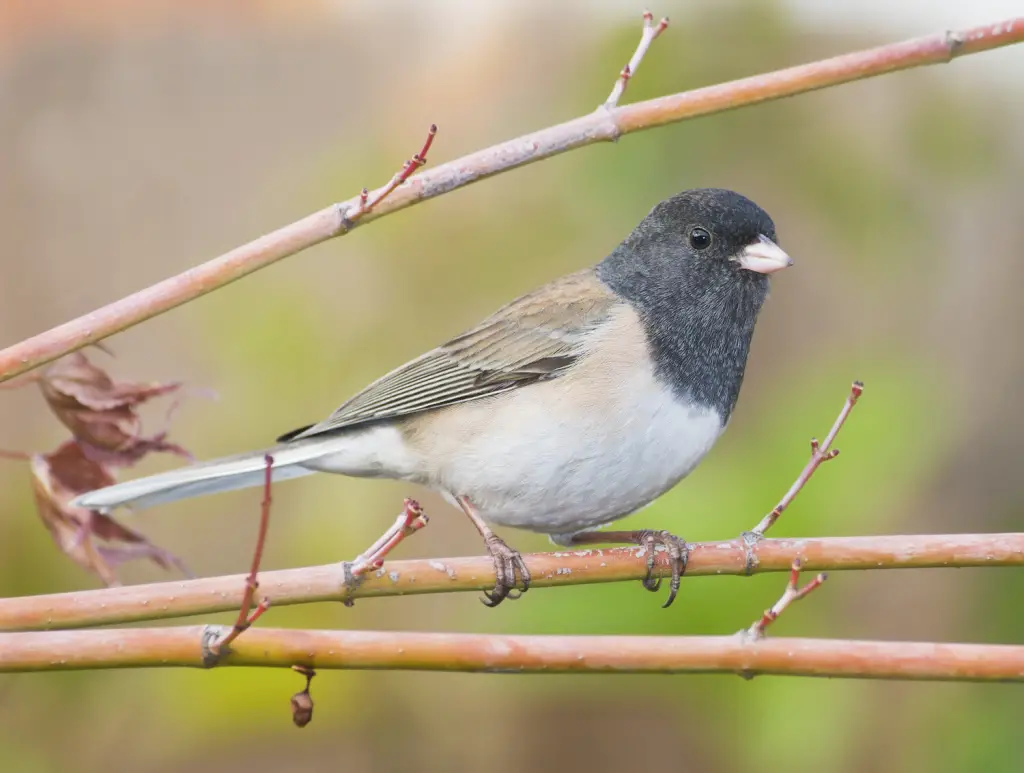
The Dark-eyed Junco is a small, sparrow-sized bird with a rounded head, short pink bill, and long tail. It has a gray or brown hood and back, white outer tail feathers, and a white belly. Juncos are often seen hopping on the ground, scratching for seeds.
Juncos are common winter visitors to Illinois feeders, where they prefer millet, cracked corn, and sunflower seeds scattered on the ground or low platform feeders. They may also visit hanging feeders for sunflower seeds. Juncos typically breed in coniferous forests, so they are less common in summer.
14. House Wren
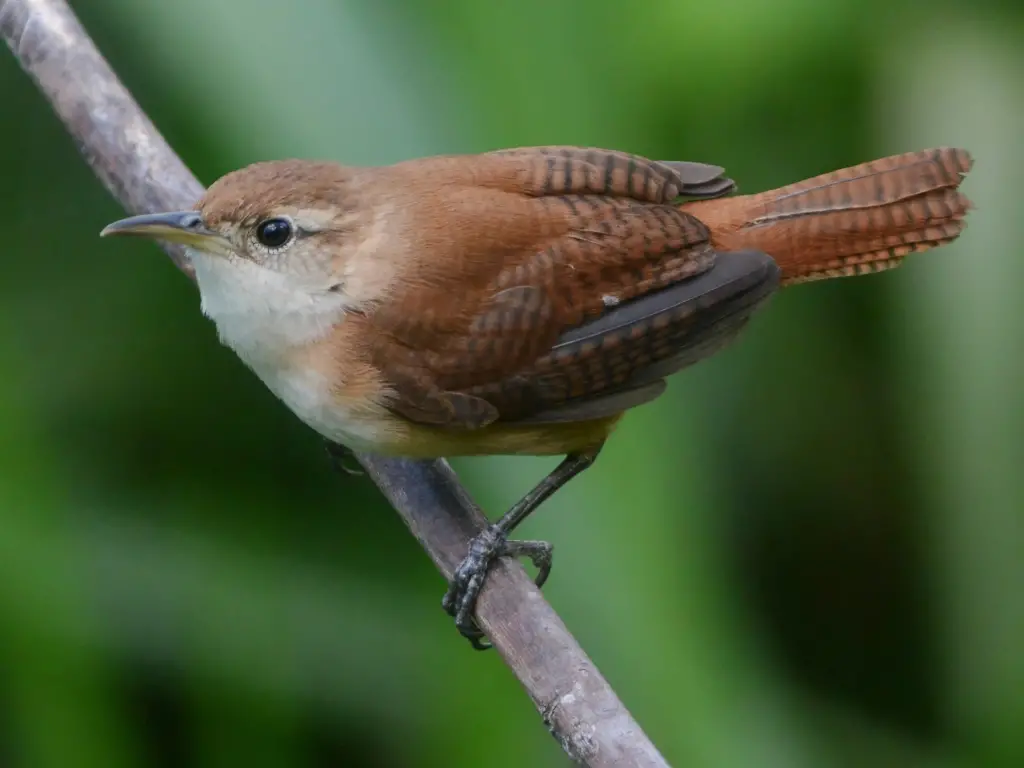
The House Wren is a small, energetic bird with a thin, slightly curved bill and upturned tail. It has brown upperparts with darker barring, pale gray underparts, and a faint eyebrow stripe. House Wrens have a loud, bubbling song that’s often described as “cheerful” or “exuberant.”
House Wrens primarily eat insects and spiders, so they don’t typically visit seed feeders. To attract them, try offering mealworms or creating brush piles for foraging. House Wrens are cavity nesters and will readily use nest boxes, especially if you place them near dense shrubs or brush piles.
15. Chipping Sparrow
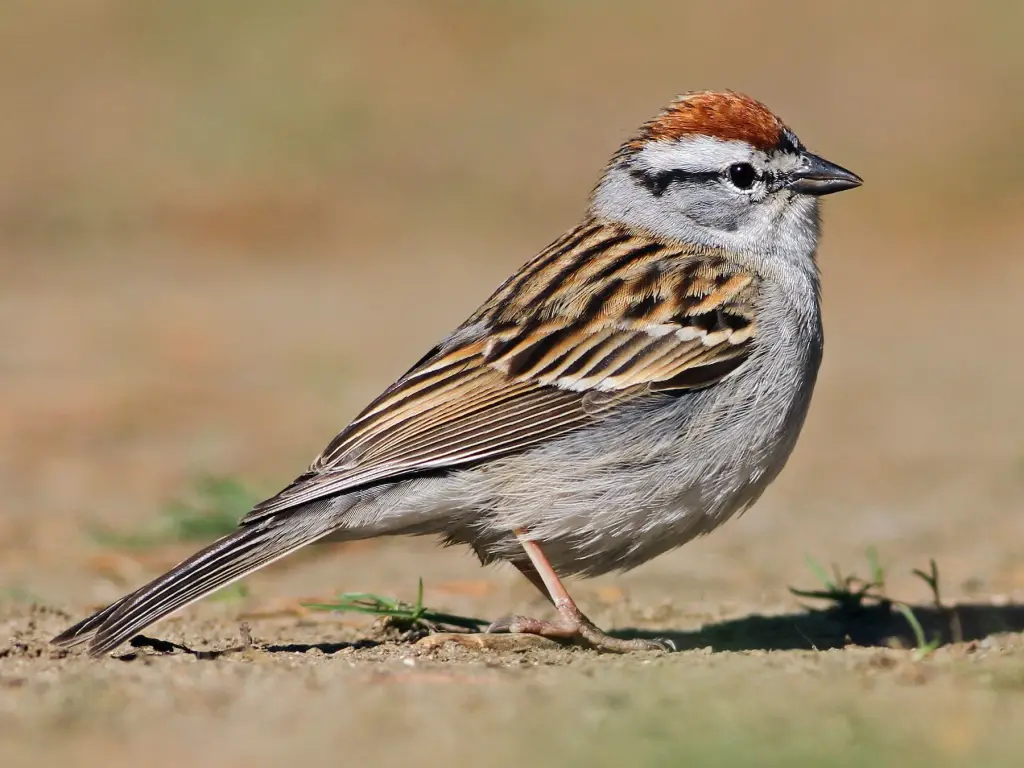
The Chipping Sparrow is a small, slender sparrow with a long tail and medium-sized bill. It has a rusty cap, white eyebrow, black eye line, and grayish underparts. Its back is brown with dark streaks, and it has two white wing bars. Chipping Sparrows have a trilling song that sounds like a sewing machine.
Chipping Sparrows love to eat small seeds, especially grass seeds. You can attract them with offerings of millet, nyjer, or black oil sunflower seeds scattered on the ground or in low-platform feeders. They often nest in small trees or shrubs in open, grassy areas.
16. Eastern Bluebird

The Eastern Bluebird is a small thrush with a big, rounded head, plump body, and alert posture. Males are a brilliant royal blue on the back and head, with a warm reddish-brown breast and white belly. Females are grayish above with a subdued blue tinge in the wings and tail.
Bluebirds primarily eat insects, so they don’t typically visit seed feeders. To attract them, offer mealworms in a shallow dish or tray feeder. Bluebirds are cavity nesters and will readily use nest boxes, especially if you place them in open, grassy areas with scattered trees.
17. Red-winged Blackbird

The Red-winged Blackbird is a medium-sized songbird with a stocky body and long, rounded tail. Males are glossy black with bright red and yellow shoulder patches. Females are streaky brown with a pale throat and eyebrows. Red-winged Blackbirds are often seen perching on cattails or reeds in marshes and wetlands.
Red-winged Blackbirds primarily eat insects and seeds. They may visit feeders for cracked corn, sunflower seeds, and millet. To attract them, plant native grasses and seed-bearing flowers, or leave some standing dead corn in your garden over winter.
18. Baltimore Oriole
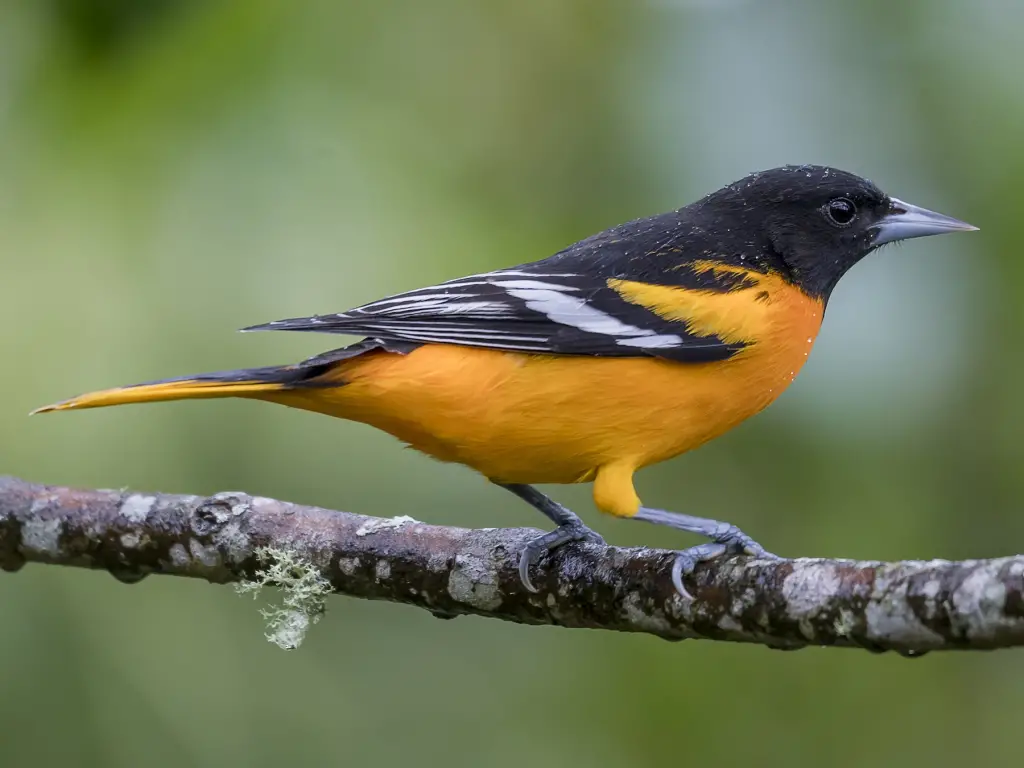
The Baltimore Oriole is a medium-sized songbird with a thick neck, long legs, and a sturdy bill. Males are flaming orange and black, with a solid black head and upper back and orange underparts. Females are more muted yellow-orange and gray. Baltimore Orioles have a rich, whistling song that’s often described as “clear” and “flute-like.”
Baltimore Orioles primarily eat insects, fruit, and nectar. To attract them, offer halved oranges, grape jelly, or specialized oriole nectar feeders. They also love to eat caterpillars, so avoid using pesticides in your yard. Baltimore Orioles weave intricate hanging nests, often in the high branches of deciduous trees.
19. Gray Catbird
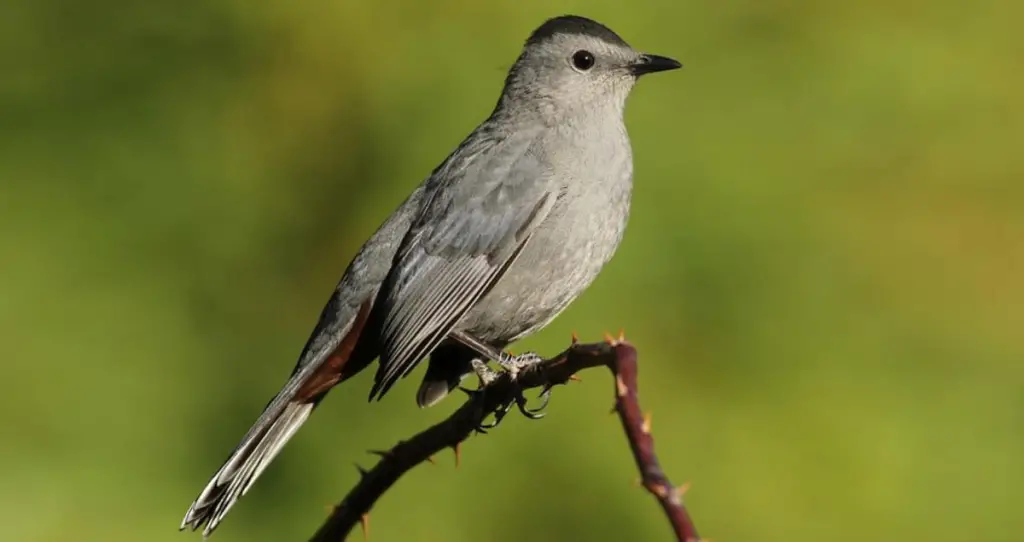
The Gray Catbird is a medium-sized songbird with a slim, long-tailed profile. It has dark gray plumage, a black cap and tail, and rusty red feathers under the tail. Catbirds are named for their cat-like “mew” call, but they are also accomplished songsters with a varied repertoire of whistles, squeaks, and mimicry.
Gray Catbirds primarily eat insects and fruit. They don’t often visit seed feeders, but you can attract them by planting native fruit-bearing trees and shrubs or offering halved oranges or grape jelly. Catbirds love dense, tangled vegetation for nesting and foraging, so consider creating a brush pile or allowing a corner of your yard to grow wild.
20. Ruby-throated Hummingbird

The Ruby-throated Hummingbird is a tiny bird with a slender bill, short wings, and a forked tail. Males have a brilliant iridescent red throat, greenback, and white underparts. Females lack the red throat and have more white on the throat and tail. Ruby-throated Hummingbirds are the only breeding hummingbird species in the eastern U.S.
To attract hummingbirds, hang nectar feeders filled with a solution of four parts water to one part white sugar. You can also plant tubular flowers like bee balm, cardinal flowers, and trumpet honeysuckle. Hummingbirds are fiercely territorial and may chase each other away from feeders and flowers.
21. American Crow
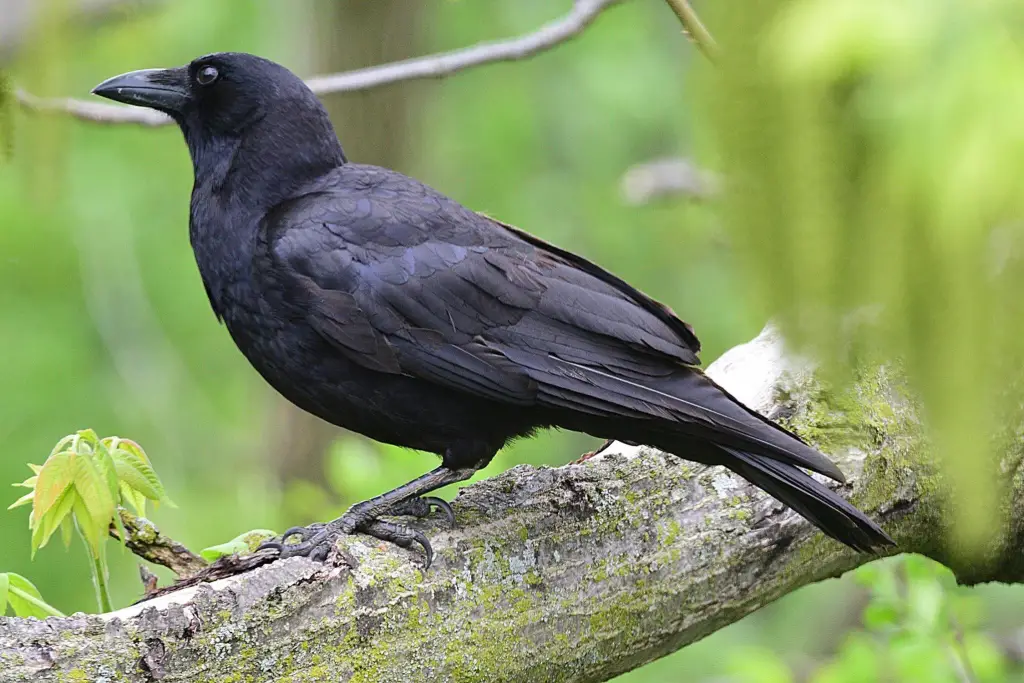
The American Crow is a large, glossy black bird with a heavy bill and fan-shaped tail. It’s an intelligent, adaptable species that’s found in a variety of habitats, from rural farmlands to urban parks. Crows have a variety of calls, including a hoarse “caw-caw” and a rattling “ruk-ruk-ruk.”
Crows are omnivorous and opportunistic, eating everything from insects and small animals to fruit, grain, and garbage. They don’t often visit bird feeders, but you might attract them by offering corn, peanuts, or even dog food. Crows are highly social and form large communal roosts in winter.
22. Cedar Waxwing
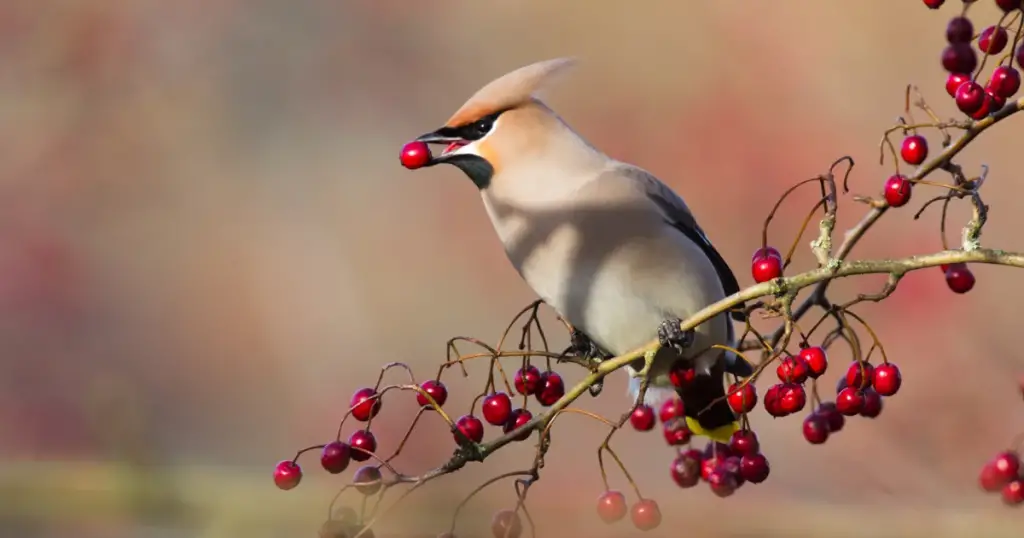
The Cedar Waxwing is a sleek, medium-sized bird with a crested head and black mask. It has smooth, silky plumage in soft shades of brown, gray, and lemon-yellow, with bright red wax-like tips on the secondary wing feathers. Cedar Waxwings have a thin, high-pitched whistle and often travel in large, nomadic flocks.
Cedar Waxwings primarily eat fruit and insects. They don’t typically visit seed feeders, but you can attract them by planting native fruit-bearing trees and shrubs like dogwood, serviceberry, and cedar. Waxwings may also visit platform feeders or birdbaths for fresh fruit or water.
23. Indigo Bunting
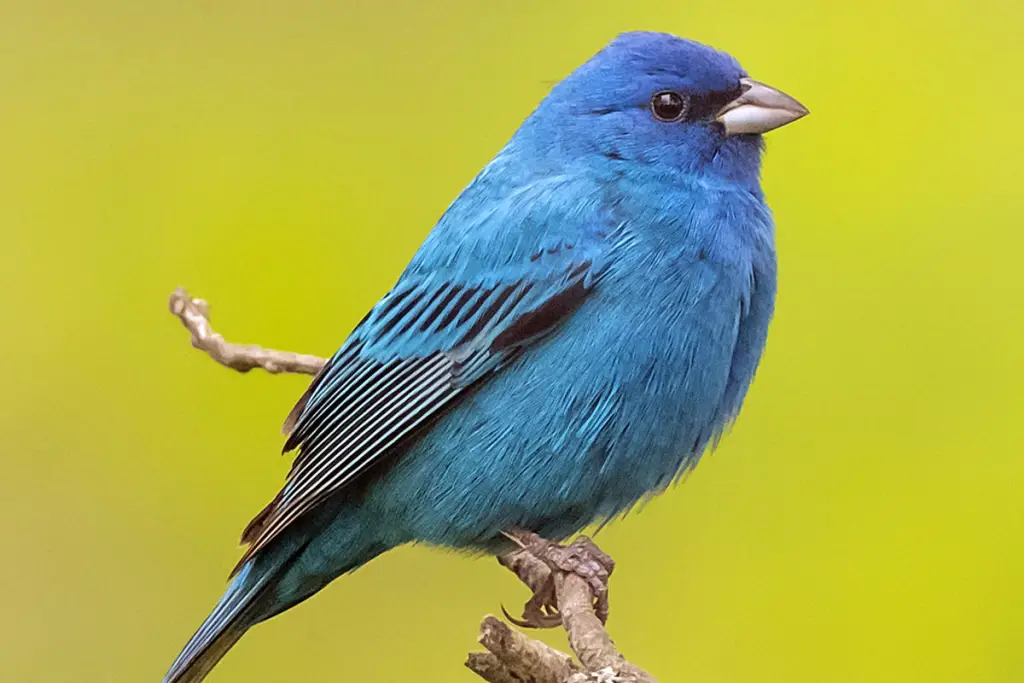
The Indigo Bunting is a small, stocky songbird with a short, thick bill and short tail. Males are a brilliant blue all over, with slightly darker wings and tails. Females are brown with faint streaking on the breast and a hint of blue in the wings and tail. Indigo Buntings has a cheerful, paired song that sounds like “what what where where see it see it.”
Indigo Buntings primarily eat insects and seeds. They may visit feeders for small seeds like nyjer and millet. To attract them, plant native seed-bearing flowers and grasses, or offer seeds in low platform feeders or on the ground.
24. Rose-breasted Grosbeak
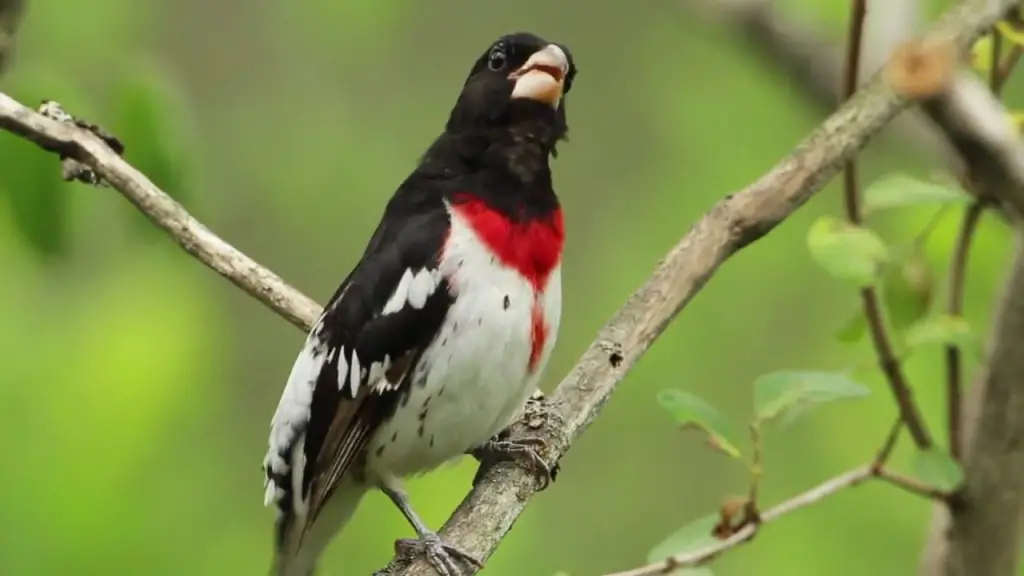
The Rose-breasted Grosbeak is a large, stocky songbird with a massive, triangular bill. Males are black and white, with a bright red chevron on the breast. Females are brown and heavily streaked, with a bold white eyebrow stripe. Both sexes have a melodious, robin-like song that’s often described as “sweet” and “mellow.”
Rose-breasted Grosbeaks primarily eat insects, seeds, and fruit. They may visit feeders for sunflower seeds, safflower, and cracked corn. To attract them, plant native seed-bearing flowers and fruit-bearing shrubs, or offer a mix of seeds in a platform or hopper feeder.
25. Eastern Towhee
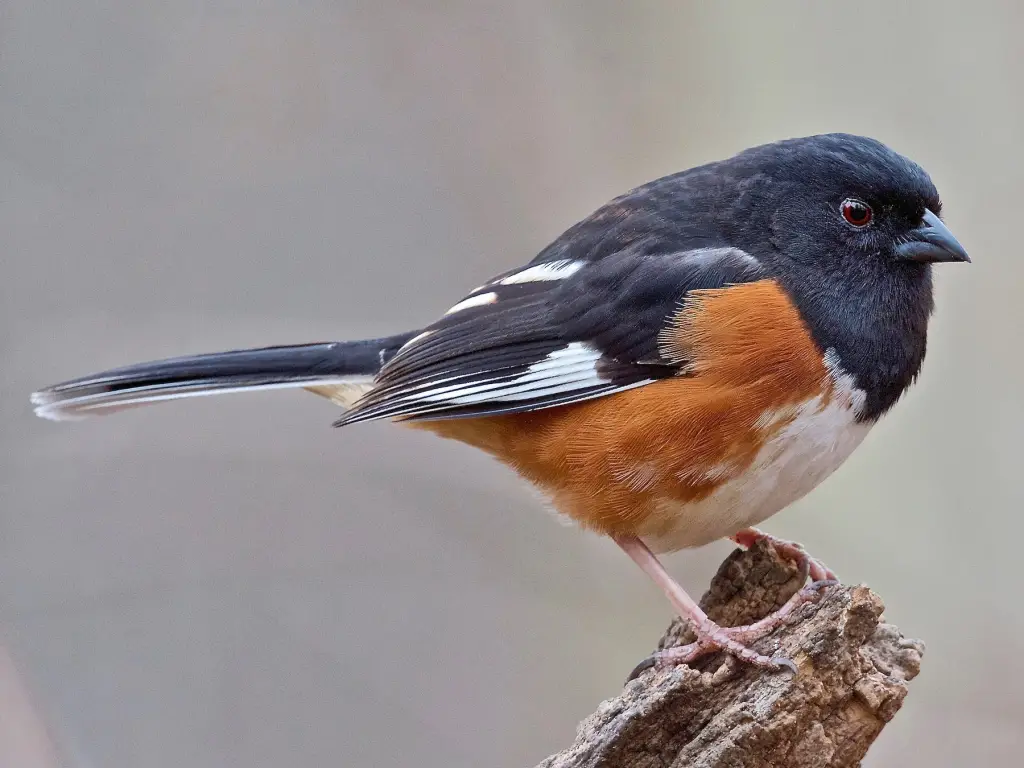
The Eastern Towhee is a large, striking sparrow with a black head and upper back, warm rufous sides, and a white belly. Its eyes are red, and it has a thick, conical bill. Females have the same pattern but are brown whereas males are black. Towhees are often heard scratching in the leaf litter, making a distinctive “toe-hee” call.
Towhees will visit ground feeders for seeds like millet, cracked corn, and sunflower. They also love to forage in brush piles, so consider creating one in a corner of your yard. Planting dense, low shrubs will give towhees a place to nest and find cover.
26. Hairy Woodpecker

The Hairy Woodpecker is a medium-sized woodpecker with a long, chisel-like bill and a blocky head. It has black and white striped upperparts, white underparts, and a large white patch on the back. Males have a red patch on the back of the head. Hairy Woodpeckers look very similar to Downy Woodpeckers but are larger with a longer bill.
Hairy Woodpeckers love suet and will also visit feeders for sunflower seeds, peanuts, and other nuts. They excavate nest holes in dead trees or large branches, so consider leaving dead wood in your yard to attract these striking birds.
27. Red-breasted Nuthatch

The Red-breasted Nuthatch is a small, compact bird with a short tail and long, pointed bill. It has a blue-gray back, rusty underparts, and a black crown and eye stripe. Like other nuthatches, it often climbs headfirst down tree trunks and branches, probing for insects in the bark.
Red-breasted Nuthatches love suet, peanuts, and sunflower seeds. They may also visit feeders for mealworms or peanut butter. These birds are more common in Illinois during the winter months, when they move south from their breeding grounds in coniferous forests.
28. Tree Swallow
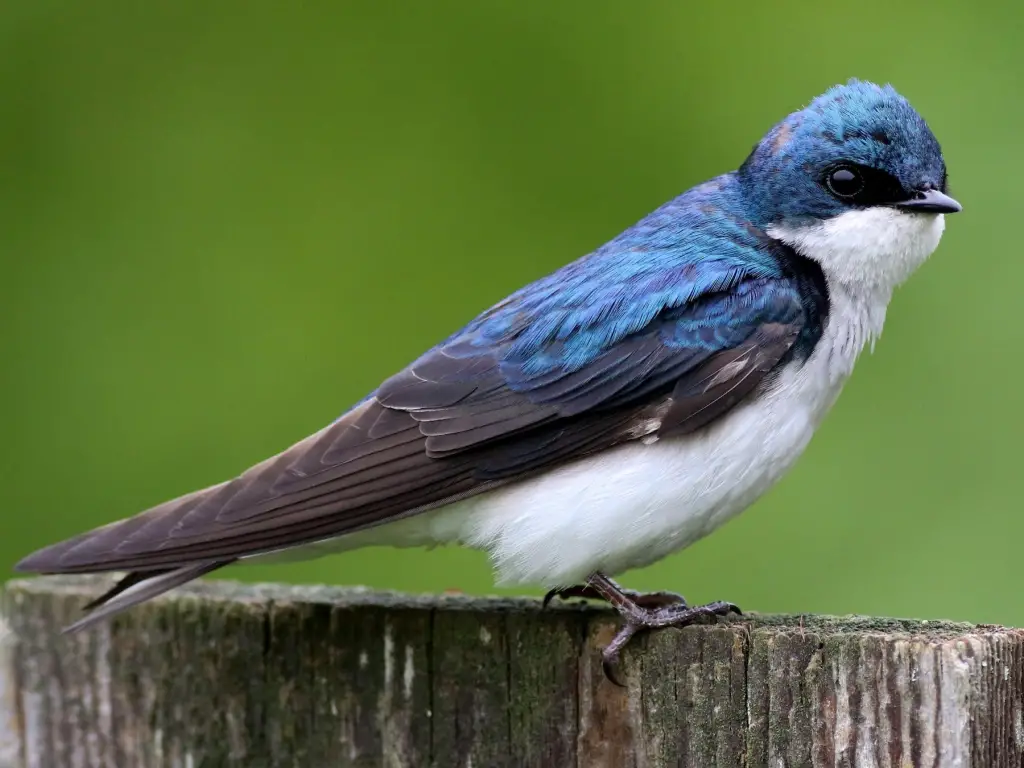
The Tree Swallow is a small, sleek bird with long, pointed wings and a slightly forked tail. It has iridescent blue-green upperparts, white underparts, and a thin black eye mask. Tree Swallows are often seen soaring and gliding over fields and wetlands, catching insects in midair.
Tree Swallows primarily eat flying insects and don’t typically visit feeders. To attract them, consider putting up a nest box near open fields or water sources. Tree Swallows are cavity nesters and will readily use man-made boxes, especially if you place them in open, sunny areas.
29. White-throated Sparrow
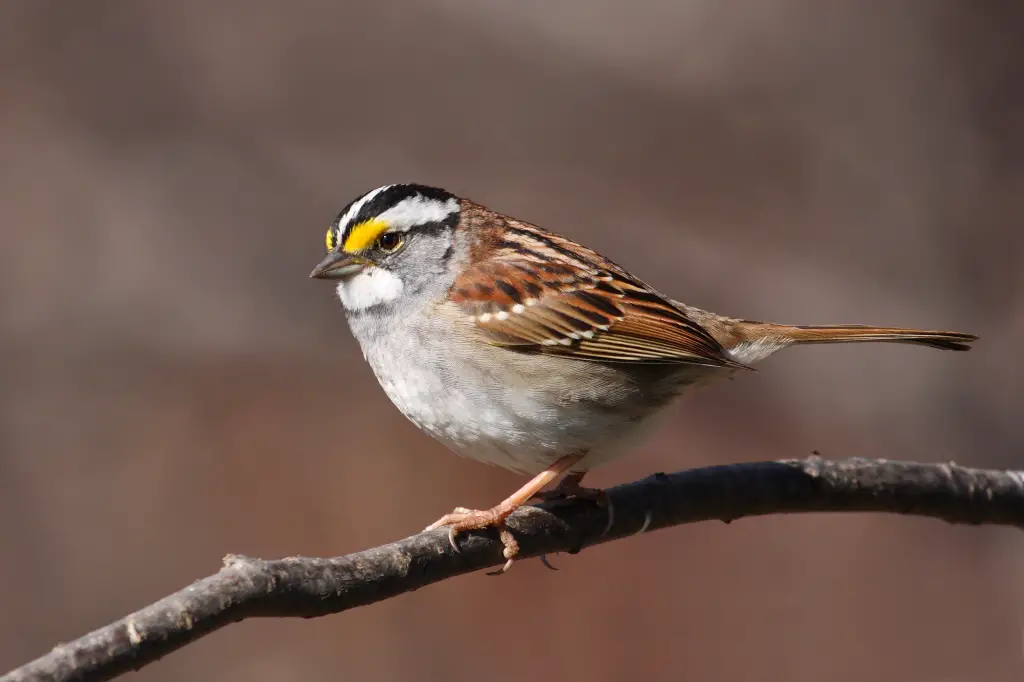
The White-throated Sparrow is a large, plump sparrow with a long tail and a distinctive facial pattern. It has a gray breast, white throat, and yellow spots between the eyes.
Its head is striped with black and white, and its back is brown with dark streaks. White-throated Sparrows have a clear, whistling song that sounds like “Old Sam Peabody Peabody Peabody.”
White-throated Sparrows primarily eat seeds and insects. They may visit ground feeders or low-platform feeders for millet, cracked corn, and sunflower seeds. To attract them, plant native seed-bearing grasses and flowers, or create a brush pile for cover and foraging.
30. Chimney Swift

The Chimney Swift is a small, sooty-gray bird with long, narrow wings and a short, stubby tail. It has a small head and a wide, gaping mouth adapted for catching insects in flight. Chimney Swifts are often seen flying erratically over cities and towns, twittering constantly.
Chimney Swifts primarily eat flying insects and don’t visit feeders. To attract them, consider leaving your chimney open and uncapped during the summer months. Chimney Swifts are unable to perch like most birds, so they roost and nest inside chimneys or other vertical structures.
Attracting Birds to Your Illinois Backyard
Now that you know some of the common backyard birds found in Illinois, you may be wondering how to attract more of them to your space. Here are some tips for creating a bird-friendly backyard:
- Provide a variety of food sources, including seed feeders, suet cakes, fruit, and nectar.
- Offer clean, fresh water in a birdbath or fountain.
- Plant native trees, shrubs, and flowers that provide food, shelter, and nesting sites.
- Leave some areas of your yard wild and untidy, with brush piles, dead wood, and unmowed grass.
- Avoid using pesticides and herbicides that can harm birds and their insect prey.
- Keep cats indoors to prevent them from hunting and killing birds.
- Provide nest boxes and nesting materials like pet fur, small twigs, and dried moss.
By creating a welcoming habitat for birds, you’ll be rewarded with the joy of watching these fascinating creatures up close and the satisfaction of knowing you’re helping to support local bird populations.
Conclusion
Illinois is home to a diverse array of backyard birds, each with its own unique characteristics and charms. From the brilliant red of the Northern Cardinal to the acrobatic antics of the American Goldfinch, these feathered friends add beauty, song, and life to our outdoor spaces.
Whether you’re a seasoned birder or a curious beginner, there’s always something new to discover and enjoy in the world of backyard birds.
So grab your binoculars, fill your feeders, and start exploring the wonderful world of Illinois’ backyard birds. You never know what feathered friends you might meet along the way!




